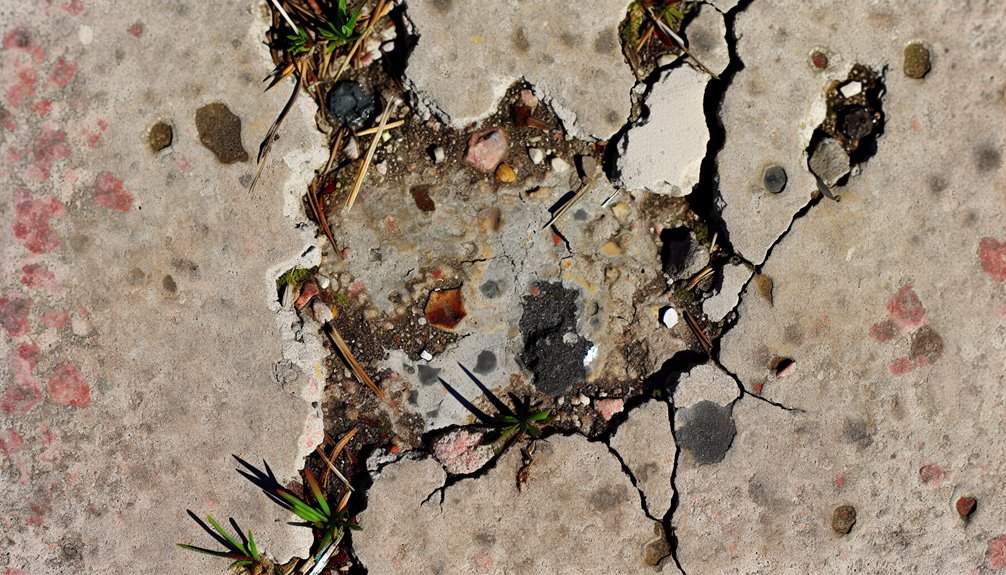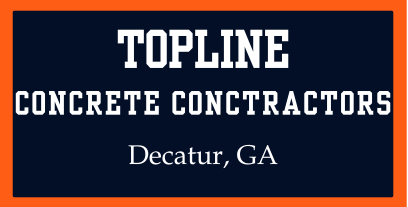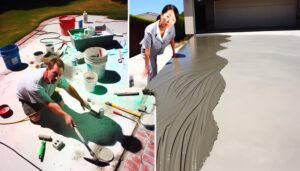
If you've noticed cracks wider than 1/4 inch or uneven surfaces in your concrete, it might be time to evaluate its condition. Surface scaling and water pooling are also signs that shouldn't be ignored, as they can lead to more significant problems down the line. Age plays an essential role, too; older concrete often requires more attention. Understanding these signs can help you decide whether to repair or replace. But before you jump to conclusions, consider what factors might influence your decision further.
Cracks and Fractures
Cracks and fractures in concrete can signal underlying issues that need your attention. Even small, hairline cracks might seem harmless at first, but they can compromise the structural integrity of your concrete over time. If you notice these cracks, don't ignore them. They often indicate problems like settling, shifting soil, or water damage.
It's essential to assess the severity and pattern of the cracks. Horizontal or wide cracks typically point to more significant structural concerns, while hairline cracks may just require a simple sealant. However, if you see cracks that widen or deepen, it's a clear sign that you should take action.
You should also keep an eye on the surrounding area. If you notice uneven surfaces or additional cracking nearby, it could mean that the overall foundation is at risk.
Addressing these issues early can save you from costly repairs later on. Regular inspections can help catch these problems before they escalate, ensuring that your concrete remains safe and sound.
Surface Scaling or Flaking
Noticing surface scaling or flaking on your concrete can be alarming, as it often indicates a deterioration of the material. This issue typically stems from freeze-thaw cycles, poor quality concrete, or insufficient curing.
When you observe changes in the surface texture, it's vital to act promptly to prevent further damage.
If the scaling is minor, you might consider using some simple repair techniques. Start by cleaning the affected area to remove any loose material and debris. Once it's clean, you can fill in the defects with a concrete resurfacer, which helps restore the surface texture and protect against further wear.
For more extensive scaling, you may need to grind down the surface or apply a thicker overlay. Keep in mind that addressing the underlying causes is important. This might involve improving drainage or using a higher-quality sealant to prevent moisture infiltration.
Ignoring surface scaling can lead to more significant issues down the line, so it's wise to tackle these problems as soon as they arise. Regular maintenance can help preserve your concrete's integrity and extend its lifespan.
Water Pooling Issues
When you notice water pooling in specific areas of your concrete, it's a clear sign to take action.
First, identify where the accumulation occurs and then assess how well your drainage system is working.
Don't forget to evaluate the severity of any surface cracks, as they could be contributing to the problem.
Identify Water Accumulation Areas
Water accumulation can be a considerable problem for your concrete surfaces, leading to potential damage and costly repairs. Identifying areas where water pools is vital to maintaining the integrity of your concrete.
Start by observing your property after rain; if you see standing water, take note of its location. Common areas include driveways, patios, and sidewalks where improper grading or cracks might exist.
Inspect for signs of moisture, like discoloration or efflorescence, which can indicate water retention. It's important to understand that these pooling areas can weaken your concrete over time.
Implementing effective waterproofing methods can help mitigate this issue. Consider applying sealants that prevent water penetration or using membranes to create a barrier.
In addition, explore drainage solutions to redirect water away from these problematic spots. Installing gutters, downspouts, or even French drains can greatly reduce water accumulation.
Assess Drainage System Efficiency
After identifying areas of water accumulation, the next step is to assess the efficiency of your drainage system. A well-functioning drainage system is essential for preventing water pooling and protecting your concrete surfaces.
Start by checking the gutters and downspouts; they should direct water away from your concrete areas. If they're clogged or poorly positioned, water can easily pool around your foundation, leading to potential damage.
Next, evaluate the grading of your landscape. The ground should slope away from your concrete surfaces to facilitate proper drainage. If you've noticed standing water, it might indicate that the grading is inadequate.
Conduct an efficiency assessment by observing how quickly water drains after a rainstorm. If it lingers for hours or days, your drainage system may need improvement.
Additionally, inspect any drainage pipes or channels for blockages or damage. These components play a key role in managing water flow. If you find issues, consider repairs or replacements to enhance the overall efficiency of your drainage system.
Tackling these aspects will help prevent further water pooling issues and protect your concrete investment.
Evaluate Surface Cracks Severity
Visible cracks in your concrete surface can signal underlying issues, especially if water pooling is present. When you notice water accumulating in certain areas, it's essential to evaluate the severity of the cracks.
Start by measuring the crack width; anything wider than 1/4 inch could indicate a serious problem. Wider cracks often lead to more significant water infiltration, which can further compromise the structural integrity of your concrete.
Next, assess the crack depth. If the cracks extend deep into the concrete, it may suggest that the foundation is settling or shifting, which is a major concern. You should also observe whether these cracks are actively growing or if they seem stable. If they're expanding, it's a clear sign that you need to take action.
In cases of severe cracks coupled with water pooling, repair mightn't be enough. Depending on the extent, you might need to think about replacing the concrete entirely to prevent future issues.
Always prioritize addressing the root cause of the water pooling, as neglecting it will only lead to recurring problems down the line.
Uneven or Sunken Areas
If you notice uneven or sunken areas in your concrete, it's essential to identify the underlying causes.
Various factors can lead to these issues, and understanding them can help you decide on the best repair techniques or whether replacement is necessary.
Let's explore what might be causing those irregularities and the options available to fix them.
Causes of Uneven Surfaces
Uneven surfaces in concrete can often be traced back to a few common causes. One major culprit is soil movement. Over time, changes in moisture levels can cause the soil beneath your concrete to expand or contract, leading to shifts that create uneven areas.
If your concrete slab is built on unstable or poorly compacted soil, you might notice these issues developing more rapidly.
Another cause is tree roots. As trees grow, their roots can push against the concrete, causing it to lift or crack. Even if the tree is planted some distance away, roots can spread out considerably, affecting the surrounding area.
If you've noticed uneven surfaces near trees, it might be time to assess the situation.
Additionally, heavy loads on your concrete can contribute to sinking or uneven areas. If you've parked heavy vehicles or placed substantial structures on your concrete slab, the weight can compress the soil beneath, leading to further issues.
Repair Techniques Available
Addressing uneven or sunken areas in your concrete is essential to maintaining both safety and aesthetics. When you notice these issues, you have several effective repair techniques at your disposal. One common solution is using patching methods. These involve filling in cracks or depressions with a specialized concrete mix, ensuring a smooth finish.
You'll want to prepare the surface properly to promote adhesion and longevity.
If your concrete surface is worn down or considerably uneven, resurfacing options might be the way to go. This technique involves applying a thin layer of new concrete over the existing surface. It not only improves the appearance but also adds a level of durability.
Make sure to select the right mix for your climate and conditions to achieve the best results.
Before diving into repairs, assess the extent of the damage. If it's localized, patching can work wonders. For larger areas, resurfacing provides a thorough solution.
Replacement Considerations
When dealing with uneven or sunken areas in concrete, deciding whether to repair or replace can be challenging. You'll want to assess the extent of the damage and consider how it impacts safety and functionality. If the issues are minor, a repair might suffice. However, if you notice significant sinking or unevenness, replacement could be the better option.
Conducting a cost analysis is essential. Repairs might seem less expensive initially, but if the underlying issues persist, you could end up spending more over time. Evaluate the repair costs against the longevity of a new installation.
Consider your long-term durability needs; if you plan to stay in your home for years, investing in a replacement may yield better results.
Also, think about the aesthetic appeal. A new concrete slab can enhance your property's look and value, while repairs may only provide a temporary fix.
Ultimately, weigh the costs and benefits of both options carefully. If you prioritize safety, functionality, and appearance, replacing uneven or sunken concrete may be the best route for you.
Stains and Discoloration
Concrete surfaces can show signs of stains and discoloration for various reasons, such as spills, mold, or weather exposure. When you notice these issues, it's crucial to assess whether they're superficial or indicative of deeper problems.
Stains can often be removed through effective stain removal techniques, which may include pressure washing or using specialized cleaning solutions. If the stains persist despite your efforts, you might need to contemplate more extensive treatment.
Discoloration can also be a sign of underlying issues. For instance, if your concrete appears unevenly colored, it could be due to improper curing or moisture problems. In such cases, color restoration might be necessary to achieve a uniform appearance.
This process can involve applying concrete dyes or sealers that not only enhance the look but also protect the surface from future staining.
If you've tried cleaning and restoring the color but still see significant issues, it might be time to reflect on repairing or replacing your concrete. Ignoring these signs can lead to more severe damage and costly repairs down the line.
Being proactive now can save you time and money later.
Age of the Concrete
The age of your concrete plays a significant role in determining its condition and potential need for repair or replacement. Generally, concrete has a lifespan of about 30 to 40 years, depending on its quality and the conditions it faces. If your concrete is nearing or has surpassed this age, it's essential to assess its state closely.
Older concrete often requires more frequent maintenance to keep it looking good and functioning properly. Cracks, uneven surfaces, or crumbling edges could indicate that it's time for repairs, especially if you've noticed these issues popping up more frequently.
If you've consistently maintained your concrete, it might still be in decent shape, but don't ignore signs of deterioration. Even with regular upkeep, age takes its toll, and you may find that repair isn't enough anymore.
Evaluating the age of your concrete alongside its current condition will help you decide whether it's time for a repair or a complete replacement.
Ultimately, staying proactive about your concrete's age can save you from more costly repairs down the line.
Frequently Asked Questions
How Can I Prevent Future Concrete Damage?
To prevent future concrete damage, you should focus on regular preventive maintenance. Apply surface sealing to protect against moisture and wear, and promptly address any cracks or issues to keep your concrete in top condition.
What Is the Average Cost of Concrete Repair Versus Replacement?
When considering costs, repair techniques typically range from $3 to $10 per square foot, while replacement can hit $8 to $15. It's essential to weigh this cost comparison based on your concrete's condition and needs.
How Long Does Concrete Repair Typically Last?
Concrete repair typically lasts around five to ten years, depending on factors like climate and usage. For better repair longevity, follow maintenance tips like sealing cracks and keeping the surface clean to extend its life.
Can I DIY Concrete Repairs Easily?
You can definitely tackle concrete repairs yourself! With the right DIY methods and repair tools, you'll find it easier than you think. Just make certain you follow instructions carefully for the best results.
What Weather Conditions Affect Concrete Repairs?
Weather conditions play an essential role in concrete repairs. Extreme temperature effects can cause cracking, while moisture impact can hinder proper curing. It's best to schedule repairs during mild, dry weather for ideal results.
Conclusion
In summary, keeping an eye on your concrete is essential. If you notice cracks wider than 1/4 inch, scaling, or pooling water, it's time to take action. Uneven surfaces and stubborn stains also signal that something's wrong. Don't forget to reflect on the age of your concrete; older surfaces may need more attention. Weigh the costs of repairs versus replacement carefully. Addressing these issues early can save you time and money in the long run!





